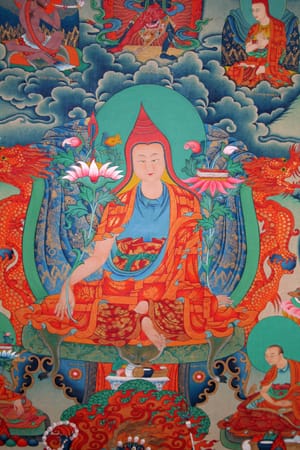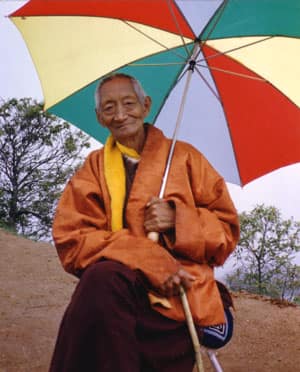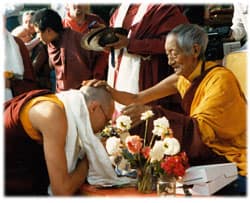KALU RINPOCHE THANGKA
Sale of a precious artifact to support the School of Chod
A rare Thangka consecrated and singed by the 1st Kalu Rinpoche
BACK STORY
[A] broad smile crossed my face as I looked down through the puffy clouds. It was 1980 and I was on my first flight to India, a trip I had hankered after for years. Having just taken refuge with His Holiness, the 16th Karmapa, I had a long list of enlightened masters to visit, and I was going to check them off, one by one. Exactly twenty-four hours from my Toronto departure, after plane, train and hair-raising winding roads, I arrived bleary eyed at Sonada Monastery, in the foothills of Darjeeling.The monk in the “Protector Gompa” at the foot of the monastery, who would become my good friend, happily helped carry my bags up the last, dizzy hundred steps. Ushered into the private quarters of Kalu Rinpoche, I found myself in the presence of an elderly man, with thin and angular body and the most beatific smile I had ever seen—and an energy of compassion and power like none I had experienced before or since.

Leaving the first brief meeting I realized I had fallen deeply in devotion! And within a few days, it was apparent that I would follow this teacher, whatever it took, and eventually go into something called a “3-year retreat.” Needless to say, I tore up my list. After several weeks of teachings, pujas, hanging out with monks and starting to learn Tibetan, I had a final audience with Rinpoche. “Is there anything I can do for you, anything you need?” I asked naively. His twinkling eyes became more serious and through his translator (Richard Barron) he said, gesturing across the courtyard, “I need nothing for myself, but the new monastery here needs a full set of Thangkas of the Shangpa Kagyu meditation deities.”
Returning to Toronto, I immediately set about to sell my house —one of only two I have ever owned in this life—and was able to send over $10,000 to cover the full costs of these paintings by renowned Bhutanese artists. When I returned to to Sonada some months later, there they were, magnificent and perfect in every way. And are still there to this day, some 30 years later.
GETTING KHYUNGPO
A few months later, a good friend in Toronto, Chris Fynn (who now coincidentally lives in Bhutan), told me he had something I might be interested in, knowing that I was now a student of Kalu Rinpoche. He then proceeded to show me a remarkable Thanka he had hand-carried back from India. Created by a close disciple of Lama Gega, the foremost Kama Kadri painter in the world, its rich detail, colors and vibrant energy struck me immediately.
.The thanka was a classic depiction of Khyungpo Naljor, surrounded by masters of the Eight Great Chariots. Though it was expensive in those days, I of course leapt at this opportunity and the thangka became a close companion and my most important possession for these many years. Just before my three-retreat on Salt Spring Island (and just before this picture was taken), I had it consecrated by Kalu Rinopoche with a short “rabney” ceremony, at which time he wrote the traditional letters OM AH HUNG on the back—and also put signed his own name! It would be an inspiration through my retreat and still hangs close by today.
KYUNGPO NALJOR
Khyungpo Naljor (sometimes pronoucned Chungpo) was one of the greatest masters to emerge out of the sea of Tibetan mahasiddhas. In fact, Jamgon Kongtrul felt he was the greatest mahasiddha since Guru Rinpoche. Of course, Kalu Rinpoche was, and is, considered the direct incarnation of this great sage. During his remarkable 150-year lifespan, he studied with over 500 masters. His two greatest masters however, were women: Niguma and Sukkasiddhi. This makes the Shangpa lineage truly unique in the annals of Tibetan Buddhism and makes it the only lineage, along with Chod itself, based on the teachings transmitted by a female, embodiments of the Enlightened Feminine. A full biography of his life and exploits can be found here. A Short Biography of Khyungpo Naljor.
Kalu Rinpoche
Khyabje Kalu Rinpoche (1905-1989) Was one of the greatest pioneers of Western Vajrayana Buddhism, and considered an emanation of Milarepa. He worked tirelessly to establish the highest level of tantric Vajrayana in the West. In spite of significant opposition from the Tibetan clergy that felt that these holy teachings should not be transmitted to a Western audience, Rinpoche established a network of centers throughout Europe, American and Asia, as well as the first 3-year retreat centers, exclusively for Westerners. Loved and respected by masters and students of all lineages, he stands among the greatest of the Tibetan Vajrayana teachers of our age, and above all, the revivifier of the illustrious Shangpa lineage, which was in danger of extinction. Many books have been written on his teachings and his life, and a brief biography for those that may be unfamiliar with his extraordinary life, a brief biogrpahy is here. A Short Biography of Kalu Rinpoche.
THE NEED
The School of Tibetan Healing Cho was founded in 2006, and has been the focus of a tremendous amount of my time and energy. The fruition of thsi activity is that many students of Chod all over the world are finding great value and its goals—of transmitting the pure, accurate and comprehensive teachings and practices of Chod to a new generation of practitioners for the benefit of all sentient beings—are being fulfilled.
But this venture is not, and was never meant to be, “profitable.” So now, in order to take the school to the next level and fully develop Modules 3 and 4, a serious writing retreat is necessary. To this aim, I am offering this very precious relic to an individual or dharma center that can appreciate its meaning and power. It may well be the only thangka in existence signed by Kalu Rinpoche. Consecrated and used as an object of practice for over 30 years, it is hoped it will continue to be a source of reverence and value for many generations of Shangpa practitioners.
REQUESTED DONATION
$10,000 US
The price of this unique sacred object reflects the amount I offered to Rinpoche for the creation of the Shangpa Thangka set at this monastery in Sonada, Darjeeling District of India (in 1980n dollars!). This seems karmically fitting. All funds will be used to promote the aims of the School of Chod, in finishing a full Chod curriculum for the benefit of many current and future practitioners.
If you are sincerely interested, please contact me for higher resolution photos or to chat personally.
Yours in Dharma,
Jinpa









